
Eduard 1/48 Bf-109G-10
| KIT #: | 82119 |
| PRICE: | $49.95 |
| DECALS: | Five options |
| REVIEWER: | Tom Cleaver |
| NOTES: | Bf-109G-10 MTT Regensburg boxing |

| HISTORY |
There were several attempts during the production run of the Bf-109G series to develop a “standard” model. The last of these was the Bf-109K-4 that appeared in the summer of 1944 powered by the 1,850 h.p. DB605D engine with a different, more streamlined cowl that got rid of the “beule” bumps of the previous sub-types.
The Bf-109G-10, which appeared in late 1944, was an
attempt to bring earlier Gustav
airframes up to a standard similar to the Kurfurst
standard with the new engine and a similar new cowling. G-10s with the DB605DM
or DB/DC engine were equipped as standard with the MW-50 booster system and had
a larger Fo 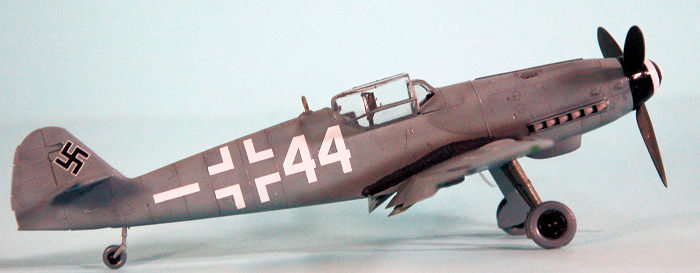 987 oil cooler housed in a deeper fairing. Approximately 2,600 G-10s
were produced from October 1944 until the war's end.
987 oil cooler housed in a deeper fairing. Approximately 2,600 G-10s
were produced from October 1944 until the war's end.
Jorg Czypionka Hunts Mosquitos:
The ranks of "Great Luftwaffe Aces" do not include my friend Leutnant Jorg Czypionka. "You have to understand,I joined the Luftwaffe because I loved airplanes and flying, not for the combat. All the choices I made about assignments, I thought first of how much skill it would take to do it, how much I could learn about flying if I did it. I was really just one of those who served."
After serving for several years as a flight instructor in Austria, Czypionka was ordered to train in the Bf-109 for a combat assignment in the fall of 1944. Leutnant Czypionka, just 23, took an assignment to 5.NJG 11, the "Wilde Sau" unit that flew single-seat Bf-109s at night, intercepting Mosquito bombers over German cities spotting their enemy with the aid of the moon and searchlights. "That airplane, it was so beautiful, it flew so well, I almost hated to have to try and shoot at it." In truth, the pilots had little success against the RAF's Light Night Striking Force. "They would send us off just before the British were to arrive. Our only hope was to get up to ten or eleven thousand meters and dive on them to catch them. If they were flying higher than eight or nine thousand meters, we had little chance, they were so fast."
The young Leutnant
nearly killed himself attempting to get a Mosquito. “The controller put me right
up in front of a group of them, and I had the altitude to dive on them. One of
them was caught by the searchlights, and I went after. I was diving on him and
he was still almost as fast as I was, so I pushed the t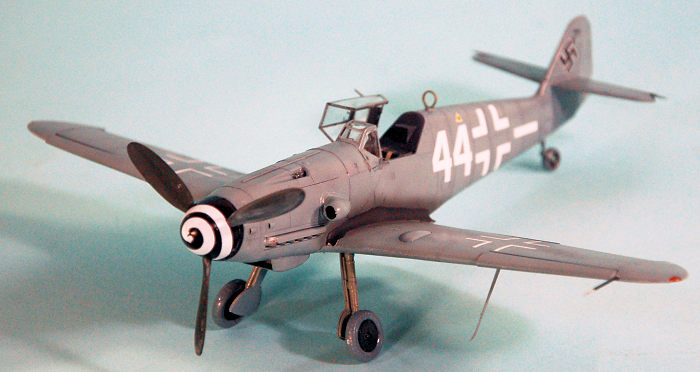 hrottle into over-boost,
into takeoff power. I knew the engine wasn't going to like it, but I wanted to
get him."
hrottle into over-boost,
into takeoff power. I knew the engine wasn't going to like it, but I wanted to
get him."
Finally, just as he was about to pull into range, "The searchlights lost him and there I was in the darkness. And then, before I could throttle back, the engine exploded!" Oil burst from the engine all over the windscreen, and the engine compartment caught fire. "I was going to bail right out, and I got rid of the hood, but then the wind blew out the fire in the engine. It was definitely dead, but I stuck with it a little longer. I got all my gear, disconnected everything, I was really calm, much more than I would have expected. I could see the altimeter read almost 5,000 meters when I got up on the back of the canopy, just like they instructed us, and pushed myself up so I would miss the rudder. There I was, falling up into space, and it was so beautiful in the night." He counted through several seconds of free fall, until he estimated his altitude at five hundred meters, at which point he pulled the ripcord.
"There I was, back to reality. I was over a district with a lot of small lakes, and I could see the moonlight and stars reflected on them." Not wanting to go into the water because he was afraid of becoming tangled in his parachute, Czypionka maneuvered towards the darker areas. At around 50 meters, he fired his flare pistol to see where he was going to land. "It was all trees! All of a sudden, something big and black went past me and I hit something very hard." Czypionka had landed on the roof of a small brick factory right next to a lake. "It took me a minute to get my bearings, and then I figured out where I was, and also discovered I couldn't find a way down."
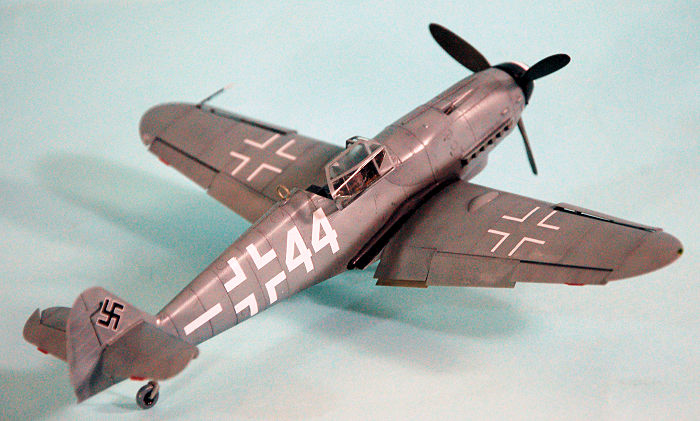 His shouts were eventually answered by the night
watchman, "an old gentleman who had that uniform with all the brass buttons,"
and his young Polish assistant, both of whom came out to see what the ruckus was
about. "The old watchman, he was going to get a ladder for me, but the young
guy, he thought I was American, he kept calling me a
terrorflieger and wouldn't let the old man go get the
ladder." Finally, Czypionka threw down his wallet with his identification. "They
went inside their office and looked at it, and when they came out it was 'Ja,
ja, Herr Leutnant!' and they fell all over themselves
saluting while they got that ladder out and helped me down." As if that wasn't
enough, he still faced a night walk of several kilometers through the forest to
get to a road where a German Army truck picked him up and returned him to
Juterborg.
His shouts were eventually answered by the night
watchman, "an old gentleman who had that uniform with all the brass buttons,"
and his young Polish assistant, both of whom came out to see what the ruckus was
about. "The old watchman, he was going to get a ladder for me, but the young
guy, he thought I was American, he kept calling me a
terrorflieger and wouldn't let the old man go get the
ladder." Finally, Czypionka threw down his wallet with his identification. "They
went inside their office and looked at it, and when they came out it was 'Ja,
ja, Herr Leutnant!' and they fell all over themselves
saluting while they got that ladder out and helped me down." As if that wasn't
enough, he still faced a night walk of several kilometers through the forest to
get to a road where a German Army truck picked him up and returned him to
Juterborg.
| THE KIT |
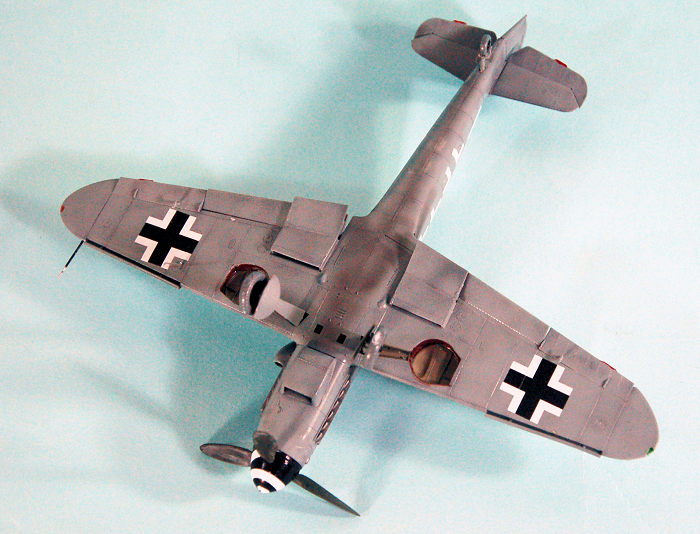 This Bf-109G-10 is the latest iteration of Eduard’s run through the
Bf-109. As with the others, it has superb surface detail and passes the accuracy
test with the “109 Polizei” - in this case it is a Bf-109G-10 as produced by
Messerschmitt at Regensburg, a relatively short production run with detail
differences between those Bf-109G-10s produced by Erla and WNF in larger numbers
(which is bound to be a future release). The assymetric late cowling which is
more streamlined than that found on the G-16 and G-14 is where the main detail
difference with other G-10s is found.
This Bf-109G-10 is the latest iteration of Eduard’s run through the
Bf-109. As with the others, it has superb surface detail and passes the accuracy
test with the “109 Polizei” - in this case it is a Bf-109G-10 as produced by
Messerschmitt at Regensburg, a relatively short production run with detail
differences between those Bf-109G-10s produced by Erla and WNF in larger numbers
(which is bound to be a future release). The assymetric late cowling which is
more streamlined than that found on the G-16 and G-14 is where the main detail
difference with other G-10s is found.
The kit provides Cartograf decals for five different Bf-109G-10s, including a Wilde Sau night fighter from 5.NJG 11, which I chose to memorialize my Jorg Czypionka, one of the most interesting Luftwaffe pilots it was my pleasure to know.
| CONSTRUCTION |
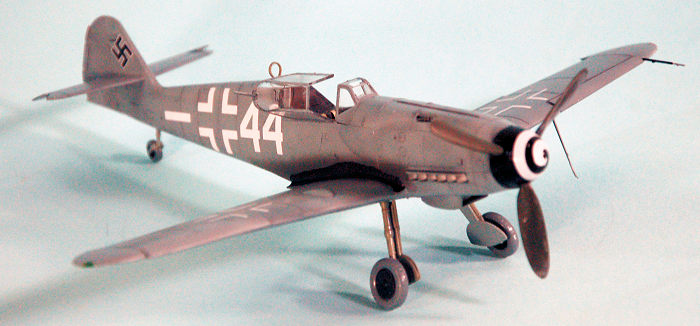 As is usual with these Eduard kits, be particularly careful to clean up
parts once they are cut off the sprue, to get rid of all little “nubs,” since
the parts design is very precise and any additional bit will throw things off in
assembly.
As is usual with these Eduard kits, be particularly careful to clean up
parts once they are cut off the sprue, to get rid of all little “nubs,” since
the parts design is very precise and any additional bit will throw things off in
assembly.
I started with the fuselage, painting the cockpit and detailing it with the Profipack photoetch, then assembling it in the fuselage and gluing the fuselage together, finishing with the new and different upper cowling part. With careful assembly, there was no need for any filler. I assembled the wing and mated it to the fuselage, then mounted all the flight control surfaces in dynamic poses.
| COLORS & MARKINGS |
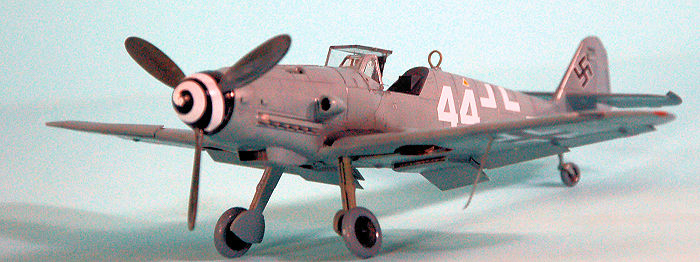 After pre-shading the model, I applied the overall RLM 76 blue-grey,
post shading a bit with some white mixed in so as not to have a monochrome
finish. I hand-painted the black wing fairings.
After pre-shading the model, I applied the overall RLM 76 blue-grey,
post shading a bit with some white mixed in so as not to have a monochrome
finish. I hand-painted the black wing fairings.
The kit decals went on without problem. Since these airplanes were repainted in the field, they did not have any of the usual stenciling other than the fuel triangle for C3 100-octane fuel.
I applied a coat of Satin clear varnish, since these airplanes were polished to improve their performance for Mosquito-chasing. I applied exhaust staining.
The landing gear and prop were attached and the canopy was posed open.
| CONCLUSIONS |
The Eduard 109 series are the best kits out there for accuracy and detail, and the Profipack releases are best since they offer several markings options and the photoetch detail. For those who have these kits in their collection, this latest release is a good addition. Highly recommended.
27 September 2018
Copyright ModelingMadness.com
Review kit courtesy of Eduard.
If you would like your product reviewed fairly and fairly quickly, please contact the editor or see other details in the Note to Contributors.
Back to the Main Page Back to the Review Index Page Back to the Previews Index Page